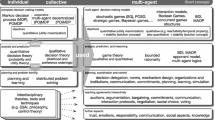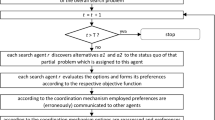Abstract
Focal points refer to prominent solutions of an interaction, solutions to which agents are drawn. This paper considers how automated agents could use focal points for coordination in communication‐impoverished situations. Coordination is a central theme of Distributed Artificial Intelligence. Much work in this field can be seen as a search for mechanisms that allow agents with differing knowledge and goals to coordinate their actions for mutual benefit. Additionally, one of the main assumptions of the field is that communication is expensive relative to computation. Thus, coordination techniques that minimize communication are of particular importance. Our purpose in this paper is to consider how to model the process of finding focal points from domain‐independent criteria, under the assumption that agents cannot communicate with one another. We consider two alternative approaches for finding focal points, one based on decision theory, the second on step‐logic. The first provides for a more natural integration of agent utilities, while the second more successfully models the difficulty of finding solutions. For both cases, we present simulations over randomly generated domains that suggest that focal points can act as an effective heuristic for coordination.
Similar content being viewed by others
References
R.C. Arkin, Cooperation without communication: Multiagent schema-based robot navigation, Journal of Robotics Systems 9(3) (1992) 351-364.
L. Aspin, Focal points, preferences and the generation of meaning, in: The 17th Arne Ryde Symposium on Focal Points: Coordination, Complexity and Communication in Strategic Contexts, Sweden (1997).
M. Bacharach, Variable universe games, in: Frontiers of Game Theory (MIT Press, Cambridge, MA, 1993) pp. 255-275.
M. Bacharach and M. Bernasconi, The variable frame theory of focal points: an experimental study, Games and Economic Behavior 19 (1997) 1-45.
M. Benda, V. Jagannathan and R. Dodhiawalla, On optimal cooperation of knowledge sources, Technical Report BCS-G2010-28, Boeing AI Center, Boeing Computer Services, Bellevue, Washington (August 1985).
V. Bhaska, Breaking the symmetry: Optimal conventions in repeated symmetric games, in: The 17th Arne Ryde Symposium on Focal Points: Coordination, Complexity and Communication in Strategic Contexts, Sweden (1997).
S. Carberry, Incorporating default inferences into plan recognition, in: Proceedings of AAAI-90, Boston, MA (July 1990) pp. 471-478.
A. Casajus, Focal points, preferences and the generation of meaning, in: The 17th Arne Ryde Symposium on Focal Points: Coordination, Complexity and Communication in Strategic Contexts, Sweden (1997).
E. Charniak and R.P. Goldman, A probabilistic model of plan recognition, in: Proceedings of AAAI-91, Anaheim, CA, July 1991 (American Association for Artificial Intelligence, 1991) pp. 160-165.
E. Charniak and R.P. Goldman, A Bayesian model of plan recognition, Artificial Intelligence 64(1) (1993) 53-79.
R.W. Cooper, D.V. DeJong, R. Forsythe and T.W. Ross, Selection criteria in coordination games: Some experimental results, The American Economic Review 80(1) (1990) 218-233.
V.P. Crawford and H. Haller, Learning how to cooperate: Optimal play in repeated coordination games, Econometrica 58 (1990) 571-595.
T. Dean and M. Boddy, An analysis of time-dependent planning, in: Proceedings of AAAI-88 (July 1988) pp. 49-54.
J.L. Devore, Probability and Statistics for Engineering and Sciences (Brooks/Cole, Pacific Grove, CA, 1991).
J. Doyle, A truth maintenance system, Artificial Intelligence 12(3) (1979) 231-272.
J. Doyle, Rational belief revision, in: Proc. of KR-91 (1991) pp. 163-174.
J. Doyle, Rationality and its role in reasoning, Computational Intelligence 8(2) (1992) 376-409.
J. Doyle, A truth maintenance system, Artificial Intelligence 12(3) (1979).
E. Durfee, V. Lesser and D. Corkill, Using partial global plans to coordinate distributed problem solvers, IEEE Trans. on Computers 36 (1987) 1275-1291.
E.H. Durfee, Coordination of Distributed Problem Solvers (Kluwer Academic, Boston, 1988).
E.H. Durfee and V.R. Lesser, Partial global planning: a coordination framework for distributed hypothesis formation, IEEE Trans. on Systems Man and Cybernetics 21(5) (1991) 1167-1183.
E.H. Durfee and V.R. Lesser, Global plans to coordinate distributed problem solvers, in: Proc. of IJCAI-87 (1987) pp. 875-883.
J. Elgot-Drapkin, Step-logic: reasoning situated in time, Ph.D. thesis, Department of Computer Science, University of Maryland, College Park, MD (1988).
J. Elgot-Drapkin and D. Perlis, Reasoning situated in time I: Basic concepts, Journal of Experimental and Theoretical Artificial Intelligence 2(1) (1990) 75-98.
O. Etzioni, Embedding decision-analytic control in a learning architecture, Artificial Intelligence 49 (1991) 129-159.
J. Farrell, Meaning and credibility in cheap-talk games, in: Mathematical Models in Economics, ed. M. Dempster (Oxford University Press, 1988).
M. Fenster, Reaching consensus without communication through the usage of focal points, Master's thesis, Bar-Ilan University, Ramat-Gan, Israel (1994).
M. Fenster, S. Kraus and J. Rosenschein, Coordination without communication: Experimental validation of focal point techniques, in: Proc. of the First International Conference on Multiagent Systems, California, USA (1995) pp. 102-116.
L. Gasser, Social conceptions of knowledge and action: DAI foundations and open systems semantics, Artificial Intelligence 47(1-3) (1991) 107-138.
D. Gauthier, Coordination, in: Dialogue(1975) pp. 195-221.
M.R. Genesereth, M.L. Ginsberg and J.S. Rosenschein, Cooperation without communication, in: Proc. of AAAI-86, Philadelphia, PA (1986) pp. 51-57.
M. Georgeff, Communication and interaction in multi-agent planning, in: Proc. of the National Conference on Artificial Intelligence, Washington, DC (1983) pp. 125-129.
J.Y. Halpern and Y. Moses, Knowledge and common knowledge in a distributed environment, Journal of the Association for Computing Machinery 37(3) (1990) 549-587.
J.C. Harsanyi and R. Selten, General Theory of Equilibrium Selection in Games(MIT Press, Cambridge, MA, 1988).
E. Horvitz, G. Cooper and D. Heckerman, Reflection and action under scare resources: Theoretical principles and empirical study, in: Proceedings of IJCAI-89, Detroit, Michigan (1989) pp. 1121-1127.
E.J. Horvitz, Reasoning under varying and uncertain resource constraints, in: Proceedings of AAAI-88(1988) pp. 111-116.
M.J. Huber and E.H. Durfee, Deciding when to commit to action during observation-based coordination, in: ICMAS 95, Proceedings of the First International Conference on Multi-Agent Systems, San Francisco, CA (June 1995) pp. 163-170.
J.B. Van Huyck, R.C. Battalio and R.O. Beil, Tacit coordination games, strategic uncertainty, and coordination failure, The American Economic Review 80(1) (1990) 234-248.
J.C. Jamison, Valuable cheap-talk and equilibrium selection, in: The 17th Arne Ryde Symposium on Focal Points: Coordination, Complexity and Communication in Strategic Contexts, Sweden (1997).
M. Janssen, Rationalizing focal points, in: The 17th Arne Ryde Symposium on Focal Points: Coordination, Complexity and Communication in Strategic Contexts, Sweden (1997).
N.R. Jennings, Coordination techniques for distributed artificial intelligence, in: Foundations of Distributed Artificial Intelligence, eds. G.M.P. O'Hare and N.R. Jennings (Wiley, New York, 1996) pp. 187-201.
M. Kandori, G.J. Mailath and R. Rob, Learning, mutation, and long run equilibria in games, Econometrica 61(1) (1993) 29-56.
H.A. Kautz and J.F. Allen, Generalized plan recognition, in: Proceedings of the Fifth National Conference on Artificial Intelligence, Philadelphia, PA, August 1986 (American Association for Artificial Intelligence, 1986) pp. 32-37.
H. Kautz, A formal theory of plan recognition, Ph.D. thesis, Technical Report 215, Department of Computer Science, University of Rochester (1987).
H. Kautz, A formal theory of plan recognition and its implementation, in: Reasoning About Plans(Morgan Kaufmann, San Mateo, CA, 1991) chapter 2, pp. 69-126.
K. Konolige and M.E. Pollack, Ascribing plans to agents, in: Proceedings of the Eleventh International Joint Conference on Artificial Intelligence, Detroit, MI (August 1989) pp. 924-930.
R. Korf, Representing and using organizational knowledge in DAI systems, in: Proceedings of the Eleventh International Workshop on Distributed Artificial Intelligence, Glen Arbor, MI (February 1992).
F. Kramarz, Dynamic focal points in N-person coordination games, Theory and Decision 40(3) (1996) 277-313.
S. Kraus and J.S. Rosenschein, The role of representation in interaction: Discovering focal points among alternative solutions, in: Decentralized Artificial Intelligence, Vol. 3, eds. E. Werner and Y. Demazeau (Elsevier Science/North-Holland, Amsterdam, 1992) pp. 147-165.
S. Kraus and J. Wilkenfeld, Negotiations over time in a multiagent environment: Preliminary report, in: Proc. of IJCAI-91, Australia (1991) pp. 56-61.
S. Kraus, J. Wilkenfeld and G. Zlotkin, Multiagent negotiation under time constraints, Artificial Intelligence 75(2) (1995) 297-345.
J. Lee, Procedural agent model for plan recognition, in: Proceedings of the Workshop on the Next Generation of Plan Recognition Systems: Challenges for and Insight from Related Areas of AI, International Joint Conference on Artificial Intelligence, Montreal, Canada (August 1995) pp. 72-77.
R. Levy and J.S. Rosenschein, A game theoretic approach to distributed artificial intelligence and the pursuit problem, in: Decentralized Artificial Intelligence, Vol. 3 (Elsevier Science/North-Holland, Amsterdam, 1992) pp. 129-146.
D.K. Lewis, Convention: A Philosophy Study(Harvard University Press, Cambridge, MA, 1969).
J. McCarthy, Circumscription-a form of nonmonotonic reasoning, Artificial Intelligence 13 (1980) 27-39.
J. Mehta, Telling tales: Actors' accounts of their behaviour in coordination games, in: The 17th Arne Ryde Symposium on Focal Points: Coordination, Complexity and Communication in Strategic Contexts, Sweden (1997).
J. Mehta, C. Starmer and R. Sugden, Focal points in pure coordination games: An experimental investigation, Theory and Decision 36(1994) 163-185.
J. Mehta, C. Starmer and R. Sugden, The nature of salience: An experimental investigation of pure coordination games, The American Economic Review 84(3) (1994) 658-673.
T.M. Mitchell, R. Keller and S. Kedar-Cabelli, Explanation-based generalization: A unifying view, Machine Learning 1(1) (1986) 47-80.
Y. Moses and M. Tennenholtz, Off-line reasoning for on-line efficiency, in: IJCAI-93, French (1993) pp. 490-495.
J.F. Nash, Two-person cooperative games, Econometrica 21 (1953) 128-140.
M. Nirkhe and S. Kraus, Formal real-time imagination, Fundamenta Informaticaeq, Special Issue on Formal Imagination 23(2,3,4) (1995) 371-390.
M. Nirkhe, S. Kraus, D. Perlis and M. Miller, How to (plan to) meet a deadline between now and then, Journal of Logic and Computation 7(1) (1997) 109-156.
D. Perlis, J. Elgot-Drapkin and M. Miller, Stop the world!-I want to think! Invited paper, International Journal of Intelligent Systems 6 (1991) 443-456.
A. Rapoport and M. Guyer, A taxonomy of 2 _2 games, in: Yearbook of the Society for General Systems Research, Vol. XI (1966) pp. 203-214.
E. Rasmusen, Games and Information(Basil Blackwell, Cambridge, MA, 1989).
S. Russell and E. Wefald, Principles of metareasoning, in: Proceedings of the First International Conference on Principles of Knowledge Representation and Reasoning, (Morgan Kaufman, San Mateo, CA, 1989) pp. 400-411.
T.C. Schelling, The Strategy of Conflict(Oxford University Press, New York, 1963).
C. Schmidt, N. Sridharan and J. Goodson, The plan recognition problem: An intersection of artificial intelligence and psychology, Artificial Intelligence 11(1) (1978) 45-83.
Y. Shoham and M. Tennenholtz, On the synthesis of useful social laws for artificial agent societies, in: Proc. of AAAI-92, San Jose, CA (1992) pp. 276-281.
L.M. Stephens and M.B. Merx, Agent organization as an effector of DAI system performance, in: Proceedings of the 9th Workshop on Distributed Artificial Intelligence, ed. M. Benda, Bellevue, Washington (September 1989) pp. 263-292.
L.M. Stephens and M.B. Merx, The effect of agent control strategy on the performance of a DAI pursuit problem, in: Proceedings of the 10th International Workshop on Distributed Artificial Intelligence, Bandera, TX (October 1990) chapter 14.
R. Sugden, A theory of focal points, The Economic Journal 105 (1995) 533-550.
K.P. Sycara, Argumentation: Planning other agents' plans, in: Proc. of IJCAI-89, Michigan (1989) pp. 517-523.
R. Weida, Knowledge representation for plan recognition, in: Proceedings of the Workshop on the Next Generation of Plan Recognition Systems: Challenges for and Insight from Related Areas of AI, International Joint Conference on Artificial Intelligence, Montreal, Canada (August 1995) pp. 119-123.
E. Werner, Cooperating agents: A unified theory of communication and social structure, in: Distributed Artificial Intelligence, Vol. 2 (Morgan Kaufmann, San Mateo, CA, 1990) pp. 3-36.
P. Young, The evolution model of bargaining, Journal of Economic Theory 59 (1993) 145-168.
P. Young, The evolution of conventions, Econometrica 61(1) (1993) 57-84.
G. Zlotkin and J.S. Rosenschein, Negotiation and conflict resolution in non-cooperative domains, in: Proceedings of AAAI-90, Boston, MA (1990) pp. 100-105.
Author information
Authors and Affiliations
Rights and permissions
About this article
Cite this article
Kraus, S., Rosenschein, J.S. & Fenster, M. Exploiting focal points among alternative solutions: Two approaches. Annals of Mathematics and Artificial Intelligence 28, 187–258 (2000). https://doi.org/10.1023/A:1018908306970
Issue Date:
DOI: https://doi.org/10.1023/A:1018908306970




